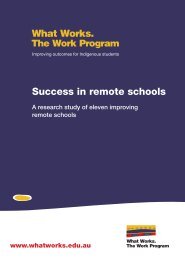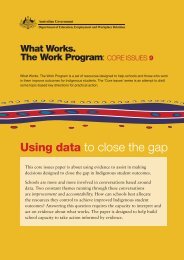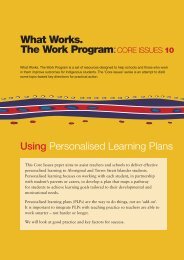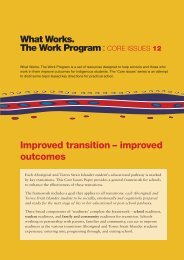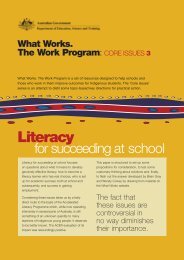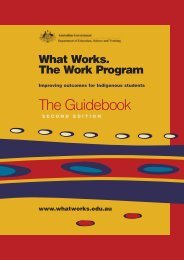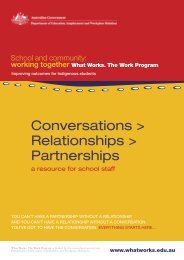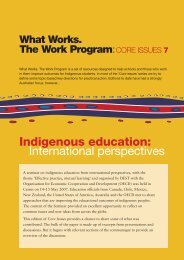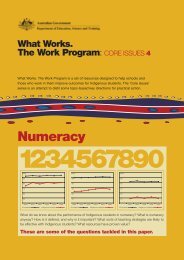THE ARTSRespond, Reflect <strong>and</strong> EvaluateConcept In Year 1 In Year 2 In Year 3 In Year 4 In Year 5 In Year 6 In Year 7 In Year 8 In Year 9RespondStudents appraise <strong>and</strong>reflect on their own<strong>and</strong> others’ art worksStudents make personalresponses to representationsof familiar <strong>and</strong> everyday artexperiences, saying how theexperiences made them feel.Students respond to theirown experiences <strong>and</strong>representations of artexperiences, noting thedifference between what isreal <strong>and</strong> what isrepresentational.Students underst<strong>and</strong> thereare a range of differentresponses <strong>and</strong> know thatothers can haveperspectives different fromtheir own, <strong>and</strong> respondsubjectively, displaying asimple comm<strong>and</strong> of artslanguage.Students make objectiveobservations about artworks in holistic statementsabout them.Students make objectiveobservations about keyfeatures of the art works ofothers recognising patternsin art works <strong>and</strong> usingappropriate terminology.Students make objectiveobservations aboutrepresentations in art worksbeyond their localenvironmentStudents respond to <strong>and</strong>reflect on features <strong>and</strong>conventions of arts works,making relationships withinthem.Students respond to <strong>and</strong>reflect on features <strong>and</strong>conventions of arts works,making relationships <strong>and</strong>comparisons between them.Students analyse their own<strong>and</strong> other’s art works <strong>and</strong>express in<strong>for</strong>mal opinionsabout them usingappropriate artsterminology <strong>and</strong> commentsin<strong>for</strong>med by research whereappropriate.In Visual Arts thestudent might, <strong>for</strong>example…In Drama the studentmight, <strong>for</strong> example…In Dance the studentmight, <strong>for</strong> example…In Media the studentmight, <strong>for</strong> example…In Music the studentmight, <strong>for</strong> example…(note this is KLAMusic, not SpecialistMusic Program)• Talk about how the muralwas made, what it means<strong>and</strong> how it makes them feel(e.g. say “We used the glueto get the wool to stick”<strong>and</strong> “the really brightcolours make me feelhappy”).• Say how they felt duringindependent dramatic play(e.g. say “I felt brave whenI escaped from the witch<strong>and</strong> made my way out ofthe bush”).• Talk about how the actionsof the characters madethem feel (e.g. say “thelion made me feel scared”).• Comment on how themedia portrays a familiarexperience (e.g. say “I likeBig Bird because he’sfunny”).• Talk about the song beinghappy or sad, slow or fast<strong>and</strong> how it makes them feel(e.g. say “this song is fast<strong>and</strong> makes me feel happy”<strong>and</strong> “It’s hard to put your‘whole self’ in”).• Recognise when an artswork looks like somethingreal <strong>and</strong> when it doesn’t<strong>and</strong> say why (e.g. say “thefrog in the painting doesn’tlook like a real frogbecause its legs are toolong <strong>and</strong> it’s pink”).• Talk about the realism ofthe characters (e.g. says“The witch in the playmade me really frightenedbut it’s only a play so she’snot real”).• Talk about the realism ofthe characters (e.g. say “Iwas really scared whenSam was a tiger <strong>and</strong> I feltsorry <strong>for</strong> the rabbit, but it’sonly pretend”).• Describe differencesbetween media textsdepicting similarcharacters (e.g. say “TheSuperman doll is differentto the one in the moviebecause it’s just a doll <strong>and</strong>it doesn’t fly”)• Use response to musicalsounds that reflect theirimmediate world (e.g. say“the violin is high <strong>and</strong>squeaky <strong>and</strong> the pianosounds like a drum”).• Say “I’m the only one inthe class who likes thatpicture <strong>and</strong> I like itbecause you can see thebrush lines in it <strong>and</strong> thecolours aren’t all mixed uptogether”.• Talk <strong>and</strong> write about theirreflections (e.g. write “Ithink that when the boyplaying the part of thefriendly alien told us thatthe air was hard to breatheit should have been louderso we could all hear it”<strong>and</strong> “Fred <strong>and</strong> Sam didn’tlike the play but I thoughtit was fun”).• Critically reflect on theskills <strong>and</strong> processes used(e.g. say “in the dance theywore hippy clothes <strong>and</strong>sort of glided across thestage” <strong>and</strong> “I think theyshould have shaken theirhips when the words said“shake <strong>and</strong> roll”).• Distinguish one shot fromthe next knowing that theorder is important (e.g. say“there was a close-up firstto get our attention”).• Know that different typesof music are <strong>for</strong> differentpurposes (e.g. say “youneed a drum <strong>for</strong> a march tokeep the 1-2-3-4 count”<strong>and</strong> “a lullaby should besoft, because it’s <strong>for</strong> ababy <strong>and</strong> you want tosoothe them to sleep”).• Compare art works inholistic ways (e.g. say “Ithink that sculpture is arepresentation of acrouching lion <strong>and</strong> thatone is a dog that isrunning”).• Say “I think that play wasabout a girl who got lost<strong>and</strong> couldn’t find her wayhome” <strong>and</strong> “it was a reallylong play but the costumeswere bright”.• Say “I think the dance wasabout six people living onan isl<strong>and</strong>” <strong>and</strong> “it was aslow dance but the propsused were really good”.• Say “the DVD of theanimals in the bush was agood film <strong>and</strong> it has lots ofanimals in it <strong>and</strong> the bushlooked dry” <strong>and</strong> “thewebsite showed long shotsof the rodeo but we thenneeded some of theaudience to show theexcitement”.• Say “the music was bright<strong>and</strong> fast <strong>and</strong> theinstruments were reallyloud some of the time <strong>and</strong>soft other times”.• Describe art worksfocusing on <strong>for</strong>ms, colours,shapes <strong>and</strong> lines (e.g. say“in this picture the colouris used to create animpression <strong>and</strong> isn’t like inreal life” <strong>and</strong> “the textureof this tree is too smooth”).• Identify the key features ofthe drama while in <strong>and</strong> outof character (e.g. say“Mary played the role ofthe NASA chief wellbecause she used a strongvoice in a confident way”).• Study a danceper<strong>for</strong>mance, video orphotograph <strong>and</strong> identifykey features (e.g. say “inthe video of the CrocFestival you could see therepetition of some of thedance sequences”)• Explain why some settingsor symbols are better thanothers <strong>for</strong> setting the mood(e.g. say “in this video thebeach on the isl<strong>and</strong> makesit seem lazy <strong>and</strong> dreamy”<strong>and</strong> “the music makes itseem dangerous”).• Say “in the claymationthere were too manymovements <strong>and</strong> it wasjerky”).• Describe the features of themusic (e.g. say “the mainbit was repeated a lot in apattern <strong>and</strong> as it got fasterit got louder <strong>and</strong> more <strong>and</strong>more instruments joinedin”).• Say or write “this paintingis called ‘Rain’ <strong>and</strong> thebrush strokes look likeraindrops <strong>and</strong> they’ve beenblurred so they look wet”).• Say or write “a mime wasused because it was abouta boy who was deaf so itwas really effectivebecause it made you thinkabout what it would be liketo be deaf”.• Say or write “the dancewas about some big cats<strong>and</strong> the movements weresmooth <strong>and</strong> gliding tomatch the way that big catswalk”.• Say or write “on the TVfurniture ad the voices arereally loud <strong>and</strong> fast so thatyou get drawn into it <strong>and</strong>feel really tense like youwant to rush <strong>and</strong> buy it; weused the same technique inour Croc Festadvertisement”• Say or write “the violinssounded all fast <strong>and</strong>scratchy <strong>and</strong> made you feellike you were in a cage <strong>and</strong>couldn’t get out”.• Compare different parts ofthe painting describingdifferences in technique(e.g. write ‘in the partbelow the road, the paint isput on using a wash lightlybut in the part above thetexture is rougher”).• Compare different parts ofa play they have seen (e.g.say “the theme was aboutpunishment <strong>and</strong> the second<strong>and</strong> fourth scenes had lotsof dramatic tension”).• Describe <strong>and</strong> comparedifferent parts of the dancefocusing on rhythm, spatialorganisation <strong>and</strong> mood(e.g. say ‘in the first partthe dancers were allspread out across the stagebut in the second part theywere huddled together insmall groups”).• Say or write “in thisnewspaper the headlineson the front page are large<strong>and</strong> with only a few wordsbut on the fourth page theheadline letters are a lotsmaller <strong>and</strong> there are morewords” <strong>and</strong> “in the majornewspapers our school ishardly ever shown in agood way but the local TVnews is always positiveabout our school”.• Identify the musicalelements which they thinkstrongly shape a piece ofmusic saying what theybelieve the composer wastrying to do (e.g. say “Ithink Mozart used the harpin that bit to make it soundlike water” <strong>and</strong> “In theBeatles’ song Imaginethere are very few differentnotes used <strong>and</strong> it is slow<strong>and</strong> an even rhythm whichmakes it sound dreamy butserious”).• Compare two paintings orsculptures describingdifferences in technique(e.g. say “one painting wasdone in watercolours usingwashes <strong>and</strong> the other wasdone using oil paints <strong>and</strong>applied with paletteknife”).• Compare two plays (e.g.say “they were both verydifferent even though theyboth had the theme ofman’s use of theenvironment, one treated itvery superficially while theother used lots of imageryto describe what the planetmight look like in thefuture”).• Compare two dancesfocusing on structure,rhythm, spatialorganisation <strong>and</strong> mood(e.g. say “the first one usedan ABA structure,repeating the first bit at theend, the rhythm wasupbeat, the second one hadtwo parts to it – the firstpart was a fast tempo <strong>and</strong>the second was slow <strong>and</strong>more flowing”).• Compare the layout of twomedia works such as twonewspapers or brochures(e.g. say “this one is atabloid <strong>and</strong> you can tellbecause the front pageheadline is only 2 wordsthat take up have the page– real sensationalism –whereas the second hasthree different headlines onit <strong>and</strong> they’re smaller”).• Compare the musicalelements used in twodifferent works (e.g. say“the Bach work is writtenas a cannon whereas theone by H<strong>and</strong>el has adistinct melody” <strong>and</strong> “thissong by Bono has a humanrights theme the musicreally fits the words – themost important lyrics havean even beat to them soyou can underst<strong>and</strong> them;but this song by …… isloud with an erraticrhythm <strong>and</strong> you can’t hearthe words”).• Describe images, colours,<strong>for</strong>ms, techniques <strong>and</strong>media (e.g. say “theAustralian Impressionistpaintings are often aboutthe bush <strong>and</strong> the sun on thetrees – the artists use lightcolours <strong>and</strong> apply it with alot of water to make itseem hot <strong>and</strong> dry”).• Use the language <strong>and</strong>terminology of drama todescribe <strong>and</strong> support theirobservations about theirown drama (e.g. say “theuse of a single spotlightmade the character seemisolated <strong>and</strong> lonely” <strong>and</strong>“my character spoke tooquickly in this scene”).• Research <strong>and</strong> identifysome ways that Aboriginaldance differs from those ofthe traditional Chinese <strong>and</strong>Isl<strong>and</strong>er <strong>for</strong>ms (e.g. say“the Aboriginal dance usesmore animal images <strong>and</strong>lots of sharp movements” )<strong>and</strong> watches dancesdirected by differentchoreographers <strong>and</strong>identifies differences instyle <strong>and</strong> interpretation).• Explain how productionprocesses impact onrepresentations (e.g. say“in the local news theyused the same video clip asthe national one becausethere are not manyjournalists who work <strong>for</strong>local TV”).• Listen to differentper<strong>for</strong>mances of a work<strong>and</strong> describe <strong>and</strong> comparethe differences ininterpretation (e.g. say “theBr<strong>and</strong>enburg Concertossound different whenplayed on a piano insteadof a harpsichord <strong>and</strong> don’tseem to ‘fill the space’around you like they wouldif you heard them played ina cathedral”).<strong>Bound</strong> <strong>for</strong> <strong>Success</strong> <strong>Scope</strong> <strong>and</strong> <strong>Sequence</strong> <strong>Statements</strong> V2 Page 79 Working Document Semester One 2007
THE ARTSThe role of the Arts in SocietyConcept In Year 1 In Year 2 In Year 3 In Year 4 In Year 5 In Year 6 In Year 7 In Year 8 In Year 9Arts in SocietyStudents demonstrate anawareness of artsexperiences in daily life intheir immediate experience.Students demonstrate anawareness of artsexperiences in daily life intheir local community.Students know that the artsare used <strong>for</strong> a range ofpurposes in their own life<strong>and</strong> that of theircommunity.Students identify <strong>and</strong>discuss specific features ofthe arts in their owncommunity.Students explore <strong>and</strong>describe how the arts areused <strong>for</strong> different purposesin a variety of cultures.Students know that the arts<strong>and</strong> artists of Australiamake contributions to oursociety, <strong>and</strong> our culture.Students compare <strong>and</strong>contrast art works fromdifferent periods of time inAustralia’s history.Students know that arts<strong>and</strong> artists makecontributions to societies,cultures <strong>and</strong> times <strong>and</strong> usethis underst<strong>and</strong>ing in theirown art works.Students know the keyfeatures of arts workswhich locate them inparticular societies,cultures <strong>and</strong> times, as wellas in contemporaryAustralian society.Students, <strong>for</strong>example…• Recognise arts inimmediate <strong>and</strong>unprompted ways.• Recognise that the arts arepresent in their lives in arange of different ways<strong>and</strong> can talk about theirown personal experiencessaying <strong>for</strong> example, “wewatched the video ofDabu,( the baby dugong)”<strong>and</strong> “people dance atweddings”.• Relate music to specialoccasions such as singing‘Happy Birthday’ onsomeone’s birthday <strong>and</strong>Christmas Carols atChristmas <strong>and</strong> theNational anthem at schoolassemblies.• Know the differencebetween a play <strong>and</strong> aconcert <strong>and</strong> that paintingsare done by painters.• Recognise that differentart <strong>for</strong>ms are combined<strong>and</strong> can say how, <strong>for</strong>example, music can addextra ‘feeling’ to a film.• Know the maindifferences between thearts <strong>for</strong>ms <strong>and</strong> can talkabout those differences insimple terms. Forexample, they might say“dances are where youmove different to whenyou walk <strong>and</strong> usually havemusic playing”, <strong>and</strong> “aplay is when you watchsomeone acting in front ofyou <strong>and</strong> they pretend theyare someone else”, <strong>and</strong>“music is when you sing orplay an instrument orlisten to someone elsedoing it”.• Can connect the arts <strong>for</strong>mswith their knowledge ofthe activity likely to begenerated by them. Forexample, they know that ifthere is a dance onsomewhere people will bemoving around to music<strong>and</strong> if someone has a newpainting it is likely to beon a piece of board orpaper <strong>and</strong> that it will be apicture of something usingpaints.• Recognise that the artsserve a social purpose aswell as a personal one;they can talk about howthe arts are used to passstories on through families<strong>and</strong> communities from onegeneration to the next.• Recognise the range of thearts in their everydaylives.• Know that in Aboriginal<strong>and</strong> Torres Strait Isl<strong>and</strong>ercommunities dance is a<strong>for</strong>m of kinship <strong>and</strong> usedto pass on stories <strong>and</strong>build cultural identity, <strong>and</strong>that their paintings areoften used to show anevent that happened or aplace of somesignificance.• Identify the different waysmusic is used on TV, <strong>for</strong>example in advertisingjingles <strong>and</strong> video clips <strong>and</strong>the variety of TV genressuch as news <strong>and</strong> cartoons,saying which they prefer<strong>and</strong> why.• Identify ways that the artsare advertised in theircommunities through themedia, posters, leaflets,<strong>and</strong> ‘word-of-mouth’.• Know the differencesbetween the key art <strong>for</strong>ms:dance, media, music,drama <strong>and</strong> visual arts <strong>and</strong>can identify to which ofthese certain artefacts,per<strong>for</strong>mances <strong>and</strong>products belong.• Know that there are someart <strong>for</strong>ms that usecombinations of <strong>for</strong>msincluding opera, musicalcomedy <strong>and</strong> video musicclips, <strong>and</strong> can makestatements about theconnections <strong>and</strong> howeffective these are [e.g.say “that video music clipof Yothu Yindi (or DeltaGoodrum) is good becausethe dance steps they use fitexactly with the lines intheir song <strong>and</strong> so the songseems to have moreenergy than if it was justsomeone singing].• Talk about the keyfeatures of the arts in theirimmediate lives <strong>and</strong> inother cultures or times inthe past.• Talk <strong>and</strong> write aboutspecific examples of artsin their society includingthe use of ritual inwedding ceremonies ofdifferent cultures (e.g.exchanging rings <strong>and</strong>saying vows), teammembers hugging eachother at football matches,the New Zeal<strong>and</strong> rugbyteam doing the Haka at thestart of a match, orAboriginal or Isl<strong>and</strong>erdancing rituals.• Can compare different artstyles from othercountries. For example,they might say “wewatched a French cartoon<strong>and</strong> there was lots ofviolence compared withour cartoons”, <strong>and</strong> “I readthe Aboriginal story of‘Mar the Cockatoo’ <strong>and</strong> itwas different to storiesthat I read at homebecause it seemed morerealistic as if it could havereally happened”.• Show an underst<strong>and</strong>ing ofthe ways that Australiansociety is enriched byartists.• Know that nearly 10% ofthe Australian work<strong>for</strong>ceare artists, identifying thesorts of things thesepeople do, <strong>and</strong> can explainwhat this means in termsof the importance of thearts in Australian society.• Know what it means to bean ‘amateur’ or‘professional’ artist,identifying these in theirown community.• Know <strong>and</strong> state the majorarts events that are heldevery year as well as thosethat are not regular (e.g.Laura Dance Festival,Culture Festival) <strong>and</strong> c<strong>and</strong>escribe the arts focus ofeach of these.• Recognise <strong>and</strong> identify artin their local communityin its broadest senseincluding thecraftsmanship ofbuildings, infrastructure,decorations, book covers<strong>and</strong> greeting cards.• Aurally identify knownmusic as belonging to aparticular culture (e.g.Irish music, Africanmusic) <strong>and</strong> visuallyidentify artworks asbelonging to particularculture groups (AustralianAboriginal <strong>and</strong> TorresStrait Isl<strong>and</strong>er paintings,Indonesian h<strong>and</strong>-paintedfabrics) .• Make comparisons <strong>and</strong>connections between thearts of Australia duringdifferent periods of history<strong>and</strong> of different culturalgroups living in Australia.• Research <strong>and</strong> compare thedifferent art <strong>for</strong>ms used byAboriginal <strong>and</strong> TorresStrait Isl<strong>and</strong>ers, Europeans<strong>and</strong> other cultural groupsin their community.• Know that AustralianAboriginal peopleused/use the arts insignificant ways tocommunicate <strong>and</strong> createbonds between peoplegroups <strong>and</strong> can explainhow.• Undertake research tolearn that Europeansbrought the British artstraditions with them toAustralia <strong>and</strong> that over thepast 200 years Australianart has developed it’s owndistinctive style.• Analyse Australiancontemporary art <strong>and</strong>describe it (e.g. say“Australian soap operaslike ‘Home <strong>and</strong> Away’always have a person thatwe all love to hate <strong>and</strong>someone that we feel sorry<strong>for</strong>”).• Research <strong>and</strong> know thatcontemporary Australianart contributes to theeconomy <strong>and</strong> to thedevelopment of Australiansociety, <strong>and</strong> can say how.• Identify key Australianartists through historyincluding a general senseof when they lived <strong>and</strong>worked in Australia <strong>and</strong>the conditions of society atthe time. For example,they know that AlbertNamatjira was one of thefirst nationally acclaimedAustralian Aboriginalartists who contributedboth to the economy <strong>and</strong>to the artistic reputation ofAustralia <strong>and</strong> can describehow.• Know that manyAustralian musicians,actors, dancers, visualartists <strong>and</strong> media artistshave internationalreputations <strong>and</strong> can namemany of them, includingnotable Indigenous artists,describing their particularart <strong>for</strong>ms.• Knows some artists’ styles<strong>and</strong> can describe them <strong>and</strong>use them <strong>for</strong> particulareffects (e.g. use the ‘dotpainting’ techniquesdeveloped by Seurat,placing particular coloursside by side to createdepth)• Recognise <strong>and</strong> respect theissues associated with theappropriation of images<strong>and</strong> dances fromAboriginal <strong>and</strong> othercultures.• Can locate in<strong>for</strong>mationfrom a variety of sourcesabout aspects of artsworks or experiences, <strong>and</strong>use this in<strong>for</strong>mation inanalysis <strong>and</strong> evaluation.• Know <strong>and</strong> underst<strong>and</strong> thatdifferent sections ofsociety use the arts indifferent ways <strong>and</strong> c<strong>and</strong>escribe these uses (<strong>for</strong>example, they describehow the arts shape values,define social structure <strong>and</strong>in some opinions, define<strong>and</strong> shape societal ‘class’structures).• Know <strong>and</strong> underst<strong>and</strong> thataccess to the arts issometimes through‘having money to pay’such as going to thepictures, seeing anexhibition, going to theballet or theatre, but thatmany arts per<strong>for</strong>mancesare becoming increasinglyavailable to the wholepublic, <strong>and</strong> they cancritically discuss the ethicsof this situation.• Identify (<strong>and</strong> use) a rangeof <strong>for</strong>ms in drama (mime,melodrama, circus), music(rock, classical, romantic),visual arts (sculpture,painting).• Compare the majorcultural periods in one ormore countries, drawing atimeline to facilitate theircomparisons.• Explain how mediaproducts such asadvertisements <strong>and</strong> talkbackradio, illustrate achanging mediaproduction environment inAustralia, including theuse of celebrities inmarketing a mediaproduct.<strong>Bound</strong> <strong>for</strong> <strong>Success</strong> <strong>Scope</strong> <strong>and</strong> <strong>Sequence</strong> <strong>Statements</strong> V2 Page 80 Working Document Semester One 2007



